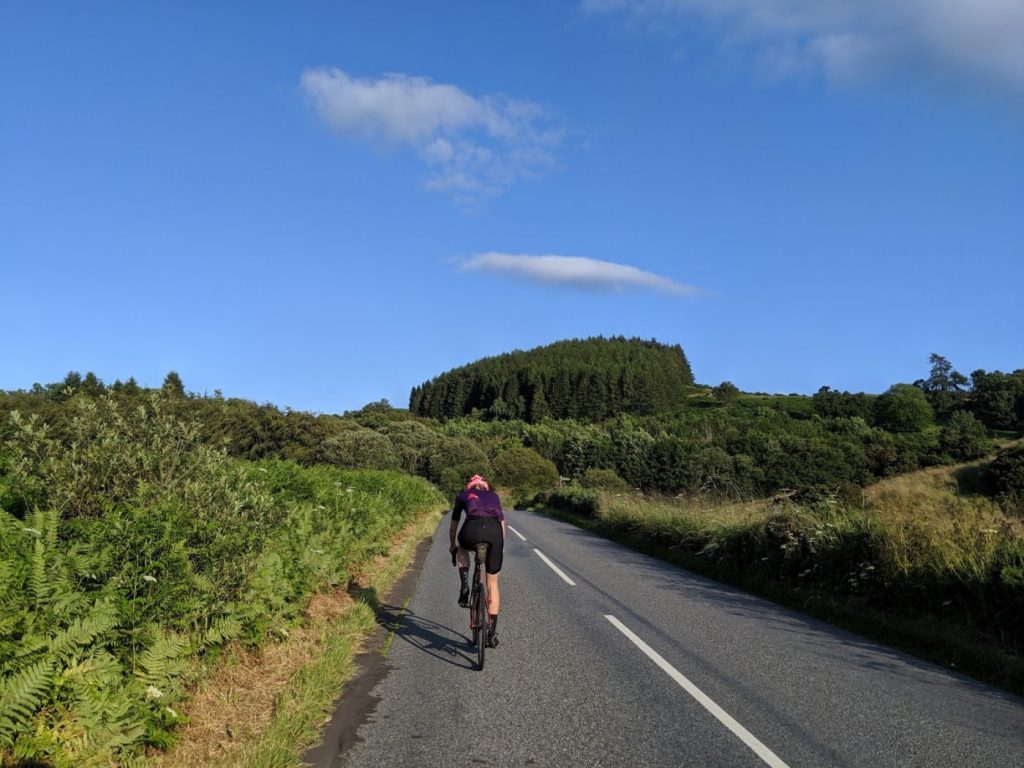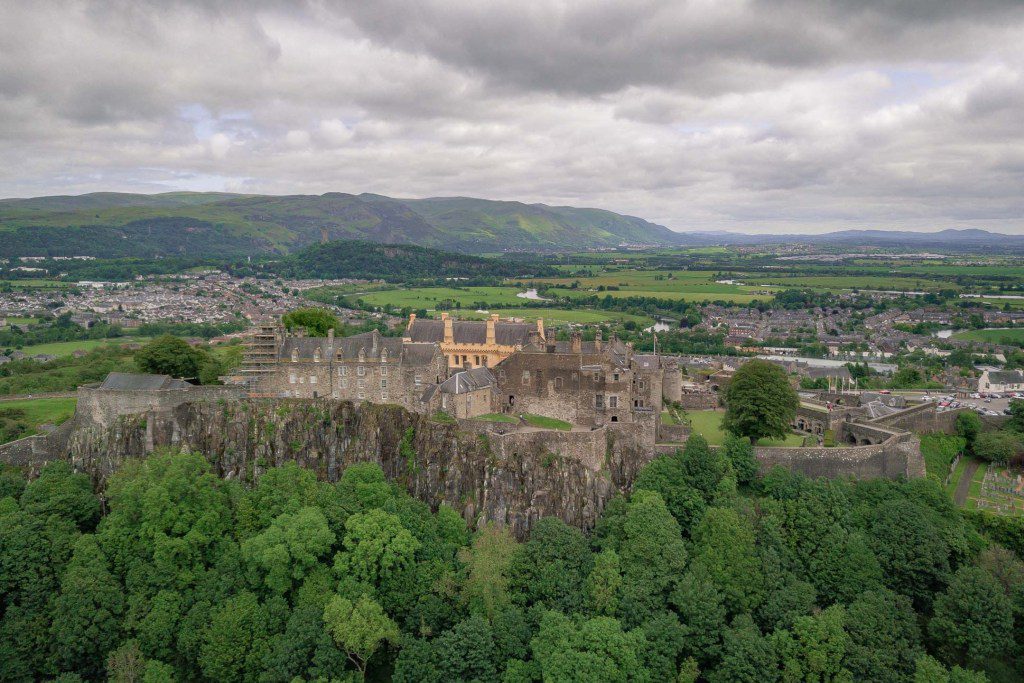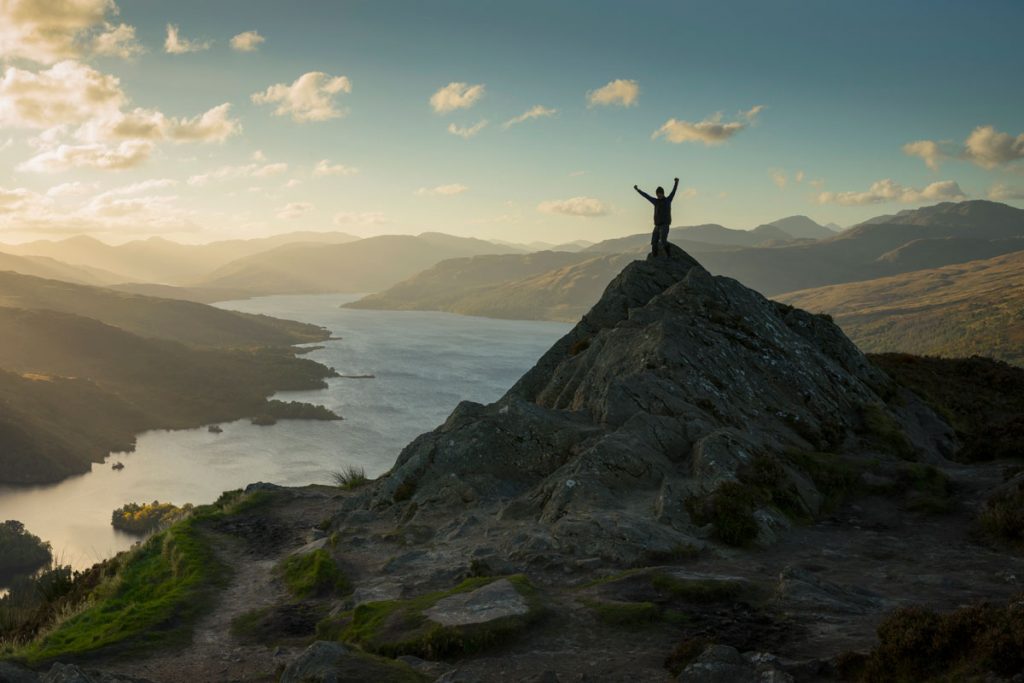Two cycling enthusiasts have managed to complete the Heart 200 in just one day.
Will and Lucinda Beresford from Glasgow completed the circuit in 14.5 hours, adding a few of their own variations to the route. In total they pedalled just over 214 miles, climbing and descending 12,300 feet (3,750 metres).
The Heart 200 recommended route, which launched on 1 July, is a spectacular circular route on existing public roads covering approximately 200 miles around Perth, Stirling, The Trossachs and Highland Perthshire. The route, coupled with the online tourist guide www.heart200.scot, has been designed to encourage more tourists to a region which since 2011 has seen a 17% drop in domestic visitor numbers [1].
Will, who has completed over 4,559 miles of cycling in 2019, was inspired to do the route after seeing it publicised on social media. Although possible in a day, other cyclists may wish to take it easier and complete the recommended route in around three to four days. Their route took them through the picturesque Stirlingshire villages of Aberfoyle and Dunblane and beautiful Perthshire villages of Killin, Pitlochry, Blairgowrie, Kinross and Crieff.
Will commented: “The Heart 200 is a cracking route. I undertook the journey with my wife, and we tailored the journey to meet our requirements, so ended up cycling more than 200 miles. We started in Aberfoyle, as it’s not too far from where we live in Glasgow. The highlight for me was cycling the first half of the route to Pitlochry. Although hilly and a real physical challenge, the scenery was spectacular. I would definitely recommend it and will continue to ride around Stirlingshire and Perthshire when I can.”
Robert Cairns, Managing Director of Heart 200 and owner of the Fortingall Hotel near Aberfeldy, said: “The Heart 200 route is very accessible for day trippers from the Central belt and we are delighted that Will and his wife have had such an enjoyable experience. They have shown that Heart 200 is not just a route for drivers. We want to encourage walkers, cyclists and bikers to use the route too. We are targeting those who want to enjoy a leisurely experience of what this region has to offer, at their own pace, giving them a unique holiday experience. Heart 200 is about getting outdoors for a walk, a round of golf, a visit to a castle or distillery or a family day out at one of the many visitor attractions in the area.”
For more information on Will’s ride, please click here.

[1] Visit Scotland report (Insights department), November 2018 – Visitors to Perthshire
The A823 road linking Yetts o’ Muckhart with Gleneagles has been closed for three weeks for essential maintenance but is now fully open again.
We announced the news of this road closure several weeks ago in order to warn visitors and suggest alternative routes. This article is to let visitors know that the roadworks have been completed and that the road is now open.
The A823 through Glen Devon and Glen Eagles is a scenic part of the Historic South section of the Heart 200 route and is a vital link across the Ochil Hills.
Roadworks have to be carried out from time-to-time, so we will do our best to bring news of any works affecting the roads around the Heart 200 route whenever they are taking place.
The Evening Standard newspaper has published a list of the 10 most spectacular road trip routes in the UK, and Heart 200 is on that list.
We are delighted to have been included in this high-profile list.
Take a look at the Evening Standard article here.

In the second in our series of guest blog articles, Jamie and Ivana describe their recent road trip around the Heart 200 route.
As we are always keen to point out, the suggested Heart 200 route map is just that – a suggestion. The route taken by Jamie and Ivana builds on our suggested route by exploring deeper into the two national parks. Read their thrilling account as they head over to the Loch Lomond and The Trossachs National Park with a visit to Loch Lomond and then take a detour up the Snow Roads route into the Cairngorms National Park to call in at Braemar.
In-between the national parks, they had a superb time seeing Andy Murray’s gold letterbox in Dunblane, taking in the Birks of Aberfeldy walk and indulging in some gastronomic delights – ice-cream in Kinross, burgers in Blair Atholl, and ….well, have a read for yourself and see what they got up to.
Here’s the link to their blog post: “Our 7 Day Self-Drive Tour of Scotland on the Exciting Heart 200 Road Trip“.
Jamie and Ivana’s regular blog posts can be found at: Wander in Two.

From time-to-time, we will open up the Heart 200 Blog page to guest bloggers so that individuals with a passion for this beautiful part of Scotland can tell a story linked to some aspect of the area around the Heart 200 route.
In this, the first in a series of guest blogs on the Heart 200 website, Matt Hay describes his love of Perthshire, his recent ski-touring trip to Glen Lyon and thoughts on the incredible Fortingall yew.
Matt’s own blog goes by the title: Stravaiger.

by Matt Hay
In the spring of 2017 I decided to commit to an especially near-flung holiday destination and spent a week in Perthshire, my home county for the last decade. This decision was motivated by a desire to keep my carbon footprint small by avoiding long haul flights abroad, but it ended up being the best holiday I’ve had for some time!
For those of you unfamiliar with Perthshire’s geography, this enormous county comprises much of central Scotland, straddling the country’s famous highlands in the north and west and the more populated ‘central belt’ in the south and east. My destination, Glen Lyon, is situated near Perthshire’s northern border. It slices an almost exactly east-west trench through the county and stretches over 50 km in length.
Despite being Scotland’s longest enclosed glen, this valley is narrow, particularly near its entrance, which makes transport difficult and has long kept the area remote, even by Scottish standards. Even today the single-lane road is not suitable for HGVs or motorhomes. It is also an almighty Cul-de-sac, at least for motorised transport…the intrepid cyclist might be able to make his way out to Glen Lochay with a bit of local knowledge.
For much of its turbulent history, Glen Lyon, has been a wild place, both in terms of its environment and its inhabitants. Its seclusion and the many mountains and forests that enclose it made it an ideal hang-out for robbers, thieves and ne’er-do-wells, who knew that no matter how long the arm of the law became, it was unlikely to ever extend the whole way down the glen and collar them. That said, before the Highland Clearances, the valley boasted a population of nearly 2,000 people but now, in the 21st century, that figure has dropped to under a 100.
For myself, I came to Glen Lyon hoping to do some ski-touring, one of my favourite spring activities in the highlands, and my girlfriend booked us a charming converted barn just east of the glen’s entrance to stay in. This meant that every morning as we headed into the glen, towards whichever mountain we had chosen to climb, we had the bonus of driving along the gorge formed by the river Lyon as it comes frothing out of the main valley.
If there are any keen cyclists reading this then I urge you to go and check out this section of road; a single track lane, which hugs the rocky sides of the canyon for almost a mile, winding with the river, which can be seen far below, rushing through chasms of rock in the forest or down falls and rapids. It is very dramatic.


Eventually the glen begins to widen and soon supports flat, riverine meadows, which are flanked on either side by steep hills and mountains. A patchwork of small-holdings and woodland cover this part of the valley with curiosities for the tourist never in short supply. First up is the picturesque Roman pack-horse bridge, soon followed by Pictish stones, then castles, memorials and ancient Christian artefacts. The glen’s most famous trinket, however, is the Fortingall yew, which, incredibly, is believed to be the oldest living thing in the world! I’m willing to bet you hadn’t even heard of it…
Nestled in a stony church yard, this dilapidated old tree, which is actually supported in one or two places (it is extremely old after all) has been dated somewhere between 3,000 and 5,000 years old. So potentially it had been around, living happily away in Scotland, for several millennia before Jesus Christ was even a twinkle in the Holy Spirit’s eye. It is mind-blowingly old, and how it has survived the centuries of climate change, storms, frosts and fires in tact is a mystery. Originally, the tree was planted by Pictish worshippers, who believed yews to provide a living link with immortality due to their long-lifespans. You have to hand it to the Picts, they were on the money with this specimen.

Far beyond Fortingall, Glen Lyon widens further still and the vistas take on a similar appearance to much of the rest of the west highlands. When we were there, bright white snow-capped hills stood out in every direction, contrasting starkly with the sombre browns of the heather below, and giving this end of the glen a particularly wild feel. It didn’t hurt that the wind was also a gale force westerly, which whistled and howled outside our car all day and blew great waves of fresh snow off the mountain summits in vast nebulous streaks, which swirled and contorted in the fury of the storm.

Beautiful and romantic as this classic vision of Scotland may sound there were elements to it that were undeniably bleak. Like the rest of the Highlands, Glen Lyon’s economy rests squarely on the backs of two familiar herbivores, the red deer and the sheep. The former throng on the hillsides in vast herds, their numbers kept artificially high by the shooting estates (whose land they live on) providing them with hay and fodder during the cold winter months. Sheep, by contrast, graze the relatively fertile pastures of the valley floor. Between the two of them, however, they keep most of the glen utterly denuded of native forest. The contrast is particularly stark in the upper reaches of the valley, where a substantial remnant of the ancient Caledonian forest* still stands. For a mile or two its geriatric pines provide an altogether different, but still resolutely Scottish, scene; one of richness and vitality.
At one point during our drive, we entered an enclosed section of the road, which is fenced off to keep the deer and sheep out, and the results were amazing. Everywhere you looked little baby Scots pine saplings were springing up amongst the heather. Free from the augmented grazing pressures that man’s favourite herbivores impose everywhere else in the valley the forest was regenerating!. It was a shockingly clear example of how damaged most of the Scottish Highland’s natural habitat is, and how quickly it could recover if we only managed the land differently and less intensively.
Of all the delights I had witnessed in Glen Lyon, it was the vision of these plucky little trees forging upwards that affected me most powerfully. It is such a beautiful place, in such a special part of the world, but it could be so much more if we only gave it the chance and the time. At the very least, “Scotland’s longest, loneliest and loveliest glen”† needs to start growing the next ‘oldest tree in the world’…just in case the ancient Fortingall yew finally snuffs it after all of these years.
* Caledonian forest typically refers to the fragments of ancient, semi-natural forest that remain in parts of the highlands. This ecosystem is the southwestern outpost of the great boreal forests that cover much of high-latitude Eurasia and North America. It would originally have supported much of the same wildlife as places like Canada and Finland, with wolves, bears and lynx hunting moose, bison, wild boar and other animals in amongst the trees.
† Sir Walter Scott’s description of Glen Lyon
A stretch of road on the main Heart 200 route is set to be closed for essential roadworks from July 1st to 22nd. The A823 through Glen Devon is the road linking Yetts o’ Muckhart with Gleneagles. This will affect the Historic South section of Heart 200.
Alternative routes that can be used as diversions include taking the B934 to Dunning, then the B8062 and A824 to Auchterarder and then Gleneagles, or the A91 to Stirling and then up the A9 to get back to Gleneagles.
Our advice is to check your own maps, plan your journey around the fact that this section of A823 is closed for three weeks and enjoy what this fantastic area has to offer.
We would also remind visitors to check the useful information at the bottom of every page on this website, particularly under the headings of: Road Safety, Travel Reports, Public Transport and Charging Points.
The four corner flags of the Heart 200 route are the historic cities of Perth and Stirling, and Scotland’s two national parks.
In developing the Heart 200 route, a key consideration was how we could link the two national parks. The Highland Perthshire route along Loch Tay and then over to Loch Tummel stood out as an attractive means of travelling from the Loch Lomond and The Trossachs National Park in the west to the Cairngorms National Park in the east.
Whilst the A827 is the obvious route along Loch Tay, a choice of routes is open to the traveler from Fearnan to Killiecrankie.
The shortest route is to turn left at Fearnan and cut through via Fortingall and Coshieville to the B846, where you turn left again and head over to Tummel Bridge.
Alternatively, you can follow the A827 all the way to the end of Loch Tay at Kenmore, and from there you can cut through to the B846 to get to Coshieville, or go along to Aberfeldy, then cut back to Coshieville, or keep heading east to Grandtully, Logierait and Ballinluig to reach the main A9.
Anyone exploring the Heart 200 route can take several other excursions in that north east corner, for example to visit Kinloch Rannoch and/or Trinafour.
This myriad of roads heading towards the Cairngorms National Park provides the Heart 200 visitor with a wide range of choices. What to see? What to do? Where to go for a walk? Where to stay? Where to eat and drink?
One thing is for sure, if you follow the Heart 200, you will get to visit Scotland’s two national parks and enjoy the Highland Perthshire journey between them.

As well as an unbelievable choice of activities and visitor attractions, the Heart 200 route has a fantastic range of accommodation options.
Whether you are looking for five-star hotels, B&Bs or campsites, this route has them all, and everything else in-between.
So, when you are planning your Heart 200 journey, a visit to the Heart 200 website will put you in touch with the kind of accommodation providers that you are looking for.
Everyone’s tastes and interests are different, but whatever it is you’re looking for, we’re confident that this area will be capable of providing you with great places to stay and friendly hosts to really enhance your Heart 200 experience.
What do you want to do on your visit to the Heart 200 route? A bit of everything or a single activity?
The good news is that you can choose whatever you want to do.
If you want to go for a walk, visit a castle, take in a distillery, get soaked in a white-water raft and maybe try a round of golf, then you couldn’t pick a better holiday destination. There are plenty of other activities and attractions, but that just gives a sample.
Alternatively, you might want to play four golf courses in four days, or walk up five mountains in five days. If you want to pursue a single activity, whilst moving on a few miles each day, then the Heart 200 route can form the basis of a fantastic holiday. We mention golf and hillwalking there because we have some of the best golf courses and mountains in Scotland, but there are plenty of other specialist interest options that you might want to consider for yourselves.
Returning to those looking for a bit of everything, there are fantastic options available for visitors from all age categories. Whether you are going to be visiting with a young family or you’re in your 50s, 60s or beyond, the range and density of activities and attractions is really spectacular. There is loads to do, and the Heart 200 website will provide you with easy access to information about the many options that we hope will be of interest to you.

Enquire about becoming a Heart 200 Ambassador by emailing us at [email protected]